Do you ever see an announcement of an upcoming exhibit or event and think, ‘I’d like to see that?’ Last April, I saw an article about Nā Kuana`ike Pāheana o Hawai`i: Artistic Perspectives of Hawai`i. It’s on display at Lyman House Museum until September. Hmmm…I’d like to see that…sometime. I promptly forgot all about it until last week.
I was having one of those days – the kind where you want to abandon the computer and the to-do-list and do something out of the ordinary routine. Lunch, I thought, preferably by the water. And took myself down to Hilo Bay Café.
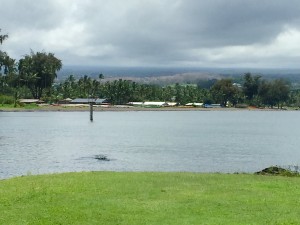
The view was wonderful. The food didn’t disappoint. I ate as slowly as I could. Fish tacos. Then I ordered dessert – salted caramel ice cream. But despite my efforts at procrastination, the meal was over.
Then I remembered the art exhibit. It was just up the road. I found a vastly different museum than I remembered. The last time I visited Lyman House was in 2009 for a traveling exhibit called Grandfather’s House, a replica of a rural Korean house in the 1930s. Grandfather must have been tired, because the exhibit is still there.
The art exhibit of paintings, prints, and photos from the 18th to 21st centuries was well worth the visit. I was surprised at the number of 18th century prints in the museum’s permanent collection. There’s something special about seeing a print by John Webber about Captain James Cook’s arrival in Hawai`i next to a 20th century depiction of the same event by Herb Kane.
LYMAN HOUSE ORIGINS
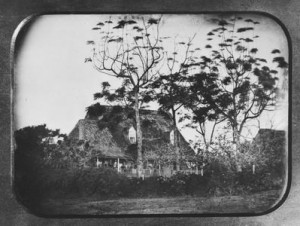
Though the thatched roof disguises the archectecture, the house built by missionaries David and Sarah Lyman in 1839 was one of the first houses on Hawai`i Island to be built in the New England style with local koa and `ohia woods. On January 27, 1839, Sarah noted: “Moved into our new house today. The carpenters left last week, the mason still at work in the chambers.”
Writing thirty years later, Isabella Bird, peripatetic traveler, noted that in Hilo the missionary houses “combine the trimness of New England with the luxuriance of the tropics; they are cool retreats, embowered among breadfruit, tamarind and bamboo through whose graceful leafage the blue waters of the bay are visible.”
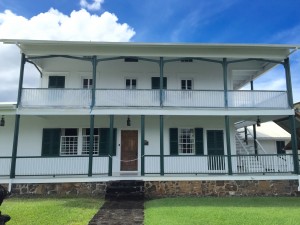
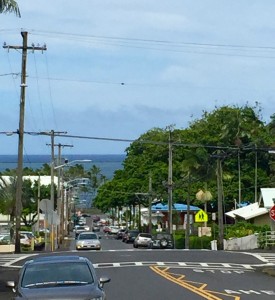
Over the years, Haili Street was extended, requiring the Lyman House to move to the side. A roof was added. The view has changed considerably. But from about the point where the house once stood, you can still look down Haili Street to the bay.
CORNICOPIA OF MINERALS
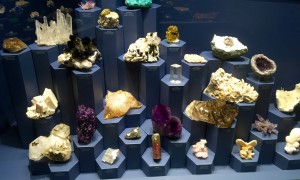
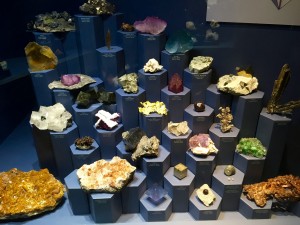
On the ground floor I revisited the permanent galleries and was astonished. Orlando Hammond Lyman, David and Sarah’s grandson, collected shells and minerals. Some had been in the family since the early 19th century. Orlando started his own collection in 1918. Not content with what he himself discovered, Orlando purchased smaller collections from throughout the world. In 1981, the collection was estimated at over 20,000 specimens. What was once a sterile almost overpowering display is now an artful arrangement glittering under tasteful lighting.
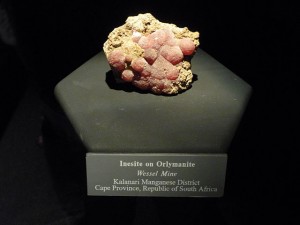
Of particular note is the only known specimen of a mineral called Orlymanite. First discovered in Orlando’s collection and native to South Africa, Orlymanite was officially identified in 1987 as a new mineral species. And it’s most famous sample is in the Lyman collection.
The Habitats of Hawai`i gallery imaginatively displays geological and natural features of Hawai`i. Particular stars are the model of a lava tube and displays of reef fish, including a ten foot shark. [I’d rather see a display shark than meet one while snorkeling.]
I returned home refreshed and ready for computer research. Like most people I travel to see exhibits in other places and overlook the delights in my own neighborhood. I drive by Lyman House several times a week on my way downtown, but it wasn’t until I rebelled from my usual routine that I took the time to pay a call.
Acknowledgements:
Featured Image: Hawai’i Visitors Bureau sign for Lyman House.
All rights reserved for photos by author.
For more photos of the Lyman Museum mineral collection, see Mineral Museums. Here.
Hawaii247. Lyman House Presents Grandfathers’s House. July 13, 2009. Here.
Lyman Museum and Mission House.
The Lymans of Hilo. Lyman House Memorial Museum. 1979.
Isabella Bird. Six Months in the Sandwich Islands. Charles E. Tuttle Company. 1978.

Sandra Wagner-Wright holds the doctoral degree in history and taught women’s and global history at the University of Hawai`i. Sandra travels for her research, most recently to Salem, Massachusetts, the setting of her new Salem Stories series. She also enjoys traveling for new experiences. Recent trips include Antarctica and a river cruise on the Rhine from Amsterdam to Basel.
Sandra particularly likes writing about strong women who make a difference. She lives in Hilo, Hawai`i with her family and writes a blog relating to history, travel, and the idiosyncrasies of life.


As we read from Dorothy in last weeks blog:
There is no place like home